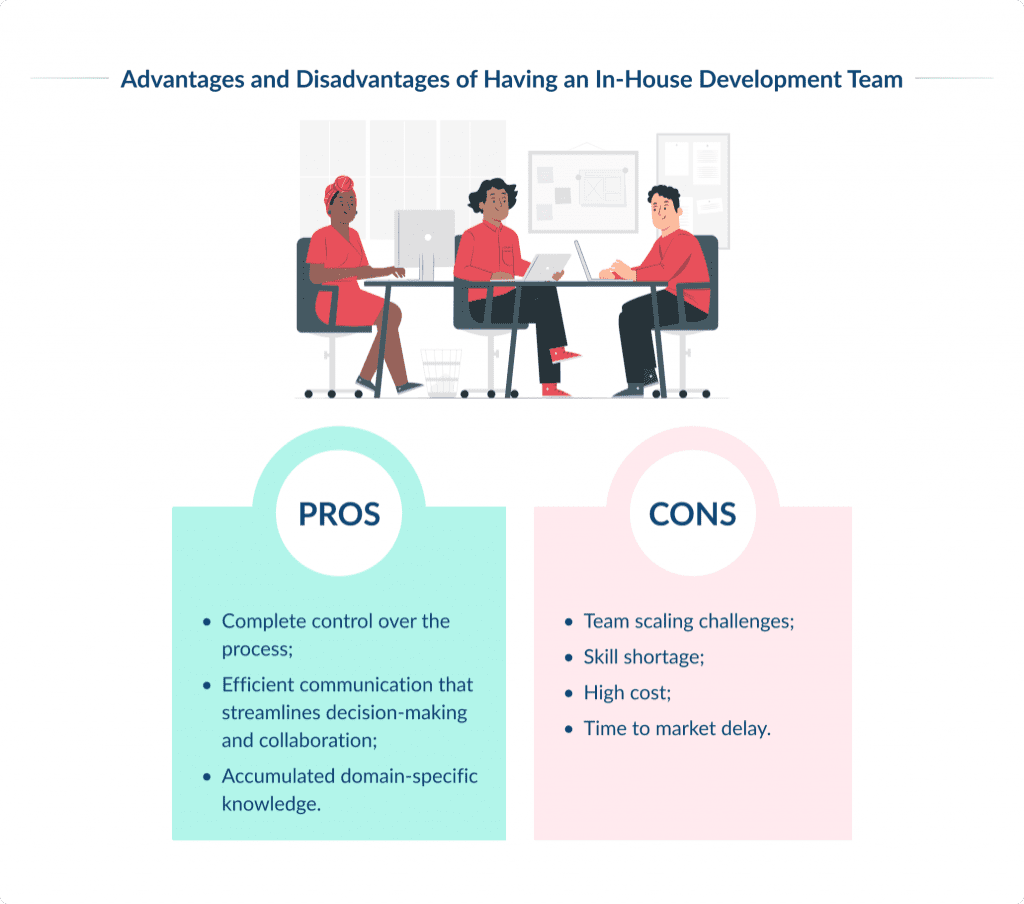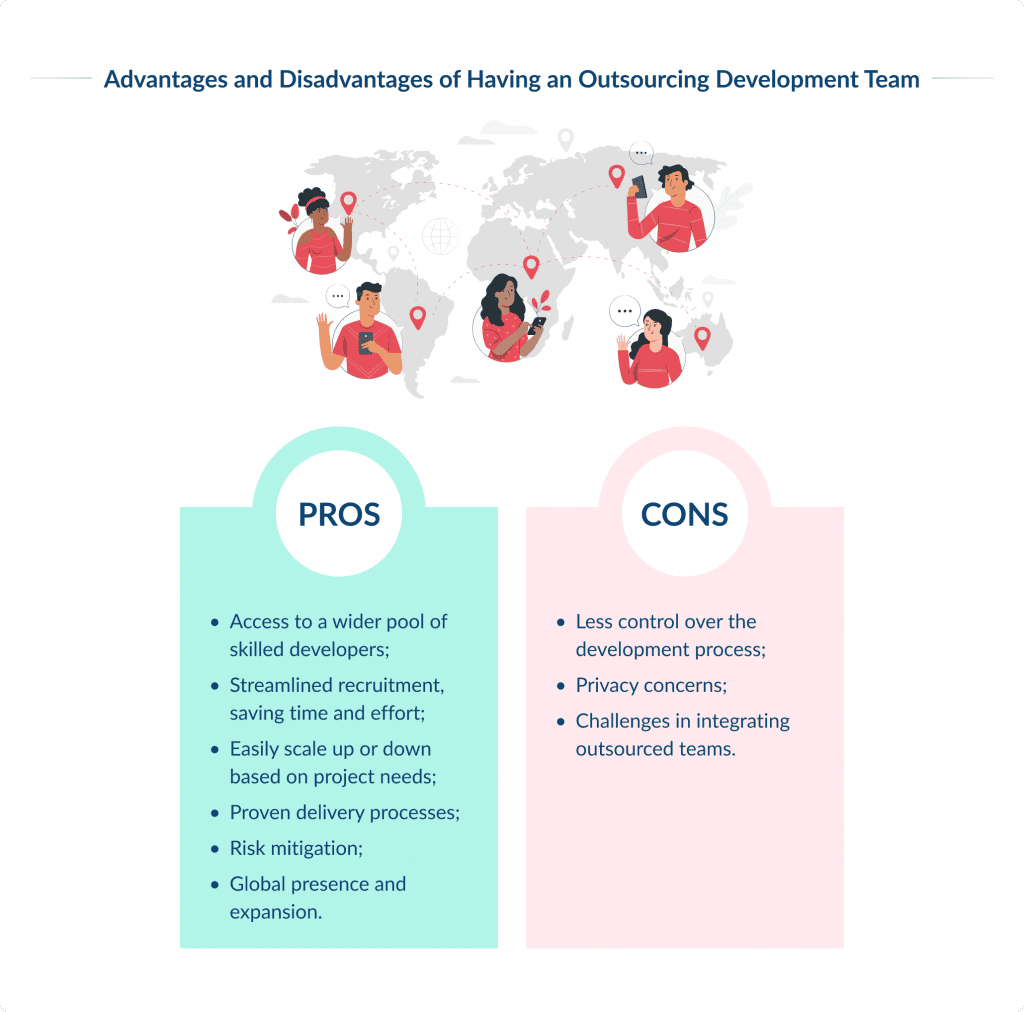In-House Software Development vs. Outsourcing
- Updated: Nov 08, 2024
- 10 min
When starting a new software project in 2025, you’ll face a choice: should you hire an outside team to develop it or do it in-house?
Outsourcing can be cheaper and faster while having an in-house team gives you more control over the development process. But there are more nuances to consider than just that.
In this article, we’ll compare in-house development with outsourcing. Understanding their advantages and disadvantages will help you decide which approach is best for your project.
Let’s dive in!
Transform your ideas into reality with top-tier software developers — contact us to get started!
The Importance of Choosing the Right Model: In-House Software Development vs. Outsourcing
Your decision between in-house software development and outsourcing can significantly impact your project’s success. Let’s explore the nuances of these two models to help you make an informed choice for your business.
When opting for an in-house team of specialists, you gain direct control over the development process. This allows you to flexibly manage your team and align their workload with your company’s goals. However, hiring the developers will take months. Besides, creating an infrastructure in-house requires a lot of time and money.
Let’s say you’re a small startup that started with I have an app idea moment.
You’ve decided to build it in-house because you want full control over the development process.
The problem is that it could take up to three months to find and hire the right developers for the job. Setting up the necessary infrastructure, like office space and equipment, will also require a lot of time and money.
During these three months or more, your competitors might seize the opportunity and launch similar apps, entering the market early. Additionally, the costs associated with hiring and setting up infrastructure could eat your budget. Your project’s success can be impacted by this.
In this scenario, outsourcing could offer a faster solution.
When collaborating with an external development team, you can start on your project immediately without the delays and upfront costs associated with in-house development. You will be able to speed up your time to market and stay competitive as technology evolves rapidly.
In the end, the best option depends on things like money, time, skills needed, and how much control you want over the process.
So, it’s really important to carefully think about these things and pick the model that suits your project and goals the most.
Let’s dive deeper into the benefits and pitfalls of each option.
This guide explains the benefits of IT outsourcing and why it’s a smart move for businesses.
In-House Software Development
In-house software development involves building software internally within your organization. Your dedicated development team works directly for your company and focuses exclusively on the product.
Advantages of In-House Development Team
Here are some perks you get when working with internal developers:
- Control
With in-house development, you have full control over the process. This way, you can manage the process and see if the software aligns with your company’s standards and that your intellectual property is protected.
- Efficient communication
Direct communication within your team streamlines decision-making and collaboration.
- Accumulated knowledge
Over time, your in-house team accumulates domain-specific knowledge.
Disadvantages of Having In-House Development Team
The possible disadvantages of having an in-house team might include:
- Team scaling challenges
Expanding the team can be difficult due to resource constraints.
- Skill shortage
Finding skilled IT specialists may be challenging.
- High cost
Hiring and training employees can be expensive.
- Time to market delay
In-house development may lead to slower time-to-market.
As we mentioned, the in-house development team inside the company knows how things work there, which is super important. That is why many companies, such as Amazon, choose this path. To make this work, Amazon invested $700 million in an upskilling program for its employees.
This is a good thing, but not all companies have the resources to invest in retraining initiatives. It is much more reasonable to hire specialists with the required skills. This is when outsourcing comes into play. Let’s explore it further. 
Outsourcing Software Development
Outsourcing involves delegating specific tasks, like digital design service or entire projects, to third-party providers.
Companies opt for outsourcing when they lack the expertise or resources to build software in-house.
The IT outsourcing industry is gaining momentum. In 2023, companies spent approximately $519 billion on outsourcing their IT activities. According to ISG Research and other IT outsourcing statistics, 92% of Forbes Global 2000 companies use IT outsourcing, and 59% use business process outsourcing.
Delegating complex technical tasks to external providers helps companies concentrate on what they do best and eliminate repetitive tasks. But that’s just one part of the picture. Let’s take a closer look at the advantages and potential drawbacks of IT outsourcing.
Benefits of Software Development Outsourcing
Here are a few benefits you can get from outsourcing:
- Access to talent
Outsourcing provides access to a wider pool of skilled developers.
- Streamlined recruitment
The outsourcing partner handles recruitment, saving time and effort.
- Scalability
Easily scale up or down based on project needs.
- Proven delivery processes
Established outsourcing providers follow tried-and-tested processes.
- Risk mitigation
When delegating IT tasks, you mitigate risks associated with technology investments, regulatory compliance, security breaches, and fluctuations in market demand.
Learn about the most impactful cybersecurity trends to safeguard sensitive data and prevent breaches.
- Global presence and expansion
Outsourcing allows you to enter new markets more easily and at lower costs without needing to set up offices overseas.
Interested in outsourcing to Ukraine? Learn how to hire a dedicated development team in Ukraine with this guide.
Potential Drawbacks of Software Development Outsourcing
Despite numerous advantages, outsourcing also has its challenges. Here are a few to be aware of:
- Visibility
Less visibility over the development process.
- Privacy concerns
Security and confidentiality may be a concern.
- Team integration
Challenges in integrating outsourced teams. 
Learn how to analyze business products effectively.
Outsourcing Software Development Examples
Here are a few examples of collaboration processes with our clients to help you better understand how IT outsourcing for small business works in practice.
Cangelo, a tutoring app for students – Mobile App Development Case Study
The company struggled to find a reliable team to develop their idea. Despite the founder’s experience, existing software vendors couldn’t meet its tight timeline, so they partnered with SpdLoad.
Our specialists thoroughly researched the market to create a clear project plan. After the research stage, we presented results to the customer, highlighting the must-have, should-have, and could-have app features.
Once the feature set was agreed upon and documentation developed, we started off with UX design.
Before the actual coding, we defined an app’s tech stack, including the backend, frontend, third-party integrations, and server. Then, our developers moved on to app development, meeting clients’ deadlines and reaching the deliverables set.
Struggling to pick technologies for your project? Discover how to choose a tech stack with our expert advice.
Thanks to outsourcing the app development to SpdLoad, the Cangelo team successfully launched their app on time.
Feel free to check out the full story about the development of the Cangelo app.
Hiring remotely doesn’t have to be daunting. Discover how to outsource your software development smoothly.
App Development for A.I.-Guided Virtual Investing Platform
Atphizyom is a unique platform that combines virtual investing, gamification, and social networking to create an immersive experience.
It’s created to help users make better investment decisions by using AI-guided virtual investing and social interactions.
They reached out to SpdLoad to tackle challenges like processing real-time asset data and creating a user-friendly interface for a complex environment.
Our team of 10 people created a product focused on improving investment analysis and financial management through AI and blockchain. We used technologies like React Native and Laravel to develop the platform. If you’re working with Laravel, these best Laravel tools and resources will streamline your workflow.
Hiring Laravel talent doesn’t have to be hard. Check out this comprehensive guide on how to find a Laravel developer.
Learn more about our collaboration with Atphizyom.
Now that we’ve explored the benefits and pitfalls of in-house teams and outsourcing, let’s identify crucial factors to consider when deciding between the two.
Key Decision Factors when Choosing Between In-House and Outsourcing
Several critical factors come into play when deciding between in-house software development and outsourcing. These include cost efficiency, time to market, quality, scalability, and expertise.
Let’s explore each of these considerations.
Cost-effectiveness
When outsourcing your IT activities, you can save costs you would spend on in-house infrastructure, staff, and training expenses.
Let’s say you’ve decided to outsource website development. After some research, you’ll see that the development rates differ from country to country. The reason for this difference is the cost of living in different regions.
For example, the cost of living in the United States is 3X more expensive than in Ukraine.
Consequently, developing a website in Ukraine is cheaper than in the US.
Check out how cost varies from one country to the other:
| The region | The cost per hour |
| Australia | $80 – $120 |
| The USA | $100 – $150 |
| The UK | $90 – $120 |
| Western Europe | $70 – $100 |
| Ukraine | $40 – $80 |
| India | $10 – $40 |
Time-to-market
Outsourcing can speed up getting your product to market by using specialized teams.
For example, if you need to build a mobile app, working with experts who’ve done it before can help you launch faster and eliminate hiccups during the development process.
Let’s assume you’re going to launch a food delivery application for your business.
The app will take you approximately 4-6 months to develop. The final timeline will depend on features, the type of development platform, and, of course, the team you choose. Read our blog for the full breakdown of mobile app development timelines.
Quality assurance
There is a misconception that in-house teams have better quality control because they’re involved in every step.
However, outsourcing to a reputable company can also mean good quality because they have their own testing processes and expertise.
At SpdLoad, for example, we provide thorough manual testing to find issues in your software.
Here’s what we do to ensure the quality of your solution:
- Check functions, usability, interfaces, and components manually.
- Evaluate how your system behaves under real-world traffic and data volumes.
- Conduct functional testing to make sure all parts of your software work properly with different inputs.
- Retest your software after changes to make sure no new issues appear.
- Do sanity testing to check basic stability and critical functions.
- Conduct smoke tests to catch simple failures early on.
Flexibility and scalability
Outsourcing lets you adjust the size of your team easily based on your project’s needs. For example, if your company grows fast, you can quickly add more developers.
In-house teams offer stability, but you can’t adapt them fast according to your current needs and goals.
Expertise and skill access
In-house teams know your company well and can customize solutions to fit your needs perfectly. That is great. But what if you start a new project and need a team of developers who can work with AI and ML? Should you hire them in-house? That can take a while. Plus, if you are living in the US, chances are, the rates for these skills will be too high.
Outsourcing gives you access to different talents and skills you might not have internally. For instance, if you need someone who’s an expert in artificial intelligence, you can find a company that specializes in that.
If you still struggle to choose between the two, don’t worry. You can get the best of both worlds. Many companies adopt a hybrid approach. Dedicated internal teams handle core functions, while external partners handle specific tasks or projects.
Remember, the right choice depends on your project’s unique requirements, budget, and long-term goals. Evaluate your options carefully to ensure a successful software development journey.
How Do I Choose the Right Model?
Choosing between in-house development and outsourcing depends on various factors.
Here are simple checklists to help you decide.
Choose In-House Development if:
- You need complete control over the development process and want your team to be directly involved in every step.
- You’re looking for a long-term investment and have the resources to build and maintain an internal team.
- Your project requires a deep understanding of your company’s goals, culture, and processes.
An in-house team can ensure alignment with your business objectives in these cases.
Choose IT Outsourcing if:
- You’re on a tight budget or need to minimize upfront costs. Outsourcing can be more cost-effective, especially if you can find skilled developers in regions with lower labor costs.
- You need to get your product to market quickly and don’t have the time to build and train an in-house team. Outsourcing to experienced professionals can accelerate the development process.
- Your project requires specialized skills or technologies that your internal team lacks. Outsourcing allows you to access a broader talent pool and expertise.
- You expect demand to change or need to adjust the size of your development team quickly. With outsourcing, you can adjust resources based on your project’s needs.
Consider a Hybrid Approach if:
- Neither in-house nor outsourcing fully meets your needs. For example, you might have a core in-house team supplemented by outsourced specialists for specific tasks or projects.
- You’re concerned about the risks associated with relying solely on internal or external resources. A hybrid approach can provide more flexibility and risk mitigation.
Ultimately, the right choice depends on your project’s specific requirements, budget, timeline, and the level of control and expertise you need.
Evaluate these factors carefully to determine whether in-house development, outsourcing, or a combination of both best fits your software project.
The cost of developing an app can vary widely. Get a clear idea of what to expect with our guide to app development costs.
Why is SpdLoad a Reliable Outsource Partner?
Outsourcing software development can be a smart move for companies looking to access top-notch specialists without breaking the bank. However, it’s crucial to choose the right outsourcing partner carefully to ensure success.
Look no further! At SpdLoad, we’ve been delivering IT expertise to businesses worldwide for over a decade. Our team has crafted numerous software solutions for clients across the globe, from the US and UK to Western Europe.
Want to improve your healthcare IT infrastructure? Learn the benefits of healthcare IT outsourcing in this comprehensive guide.
We can cover your IT needs, including services such as web and mobile app development, web design, cloud computing, cybersecurity, database development, and more. With us, you’re in good hands for all your IT needs!
Contact us today to discuss your goals and how we can reach them successfully.
Curious about where app development is headed? Our application development trends guide has the answers.













